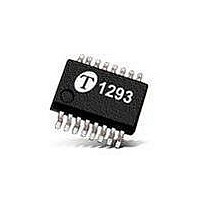1290Q16-U THAT Corporation, 1290Q16-U Datasheet - Page 4

1290Q16-U
Manufacturer Part Number
1290Q16-U
Description
Difference Amplifiers Dual Bal. Line Receiver 0 db
Manufacturer
THAT Corporation
Datasheet
1.1290Q16-U.pdf
(10 pages)
Specifications of 1290Q16-U
Lead Free Status / RoHS Status
Lead free / RoHS Compliant
Document 600121 Rev 01
performance opamps with integrated, thin-film resis-
tors. These designs take advantage of THAT’s fully
complementary dielectric isolation (DI) process to
deliver excellent performance with low current
consumption. The devices are simple to apply in a
wide range of applications.
Resistor Matching, Values, and CMRR
matching of silicon-chromium (Si-Cr), thin-film,
integrated resistors to achieve a 50 dB common
mode rejection ratio and tight gain accuracy. No
trimming is performed. As a result of their
monolithic construction, the R
within ±0.5% of the R
about 50 dB CMRR for the 1296 and 52 dB for the
1290.
controlled, the actual value of any individual resistor
is not. Lot-to-lot variations of up to ±30% are to be
expected.
input stage, consider the THAT 1280-series ICs.
These parts are laser-trimmed to improve the inher-
ent precision of our thin-film resistor process. For
demanding applications in which the source imped-
ance balance may be less than perfect, the 1200-
series ICs offer exceptional CMRR performance via a
patented method of increasing common-mode input
impedance.
Input Considerations
against input overload via an unusual arrangement of
diodes connecting the + and - input pins to the
power supply pins. The circuit of Figure 3 shows the
arrangement used for the R
applies to the other side. The zener diodes prevent
the protection network from conducting until an
input pin is raised at least 50 V above V
The THAT 1290 series ICs consist of two high
The 1290-series devices rely upon the inherent
If higher CMRR is required in a simple dual
The 1290-series devices are internally protected
However, while the resistor ratios are tightly
In+
Figure 3. Representative input protection circuit
V
EE
V
CC
R
3
1
Tel: +1 508 478 9200; Fax: +1 508 478 0990; Web: www.thatcorp.com
/R
THAT Corporation; 45 Sumner Street; Milford, MA 01757-1656; USA
2
ratio. 0.5% matching is
3
/R
R
+
-
4
4
3
side; a similar one
/R
V
EE
4
V
ratio matches
CC
Copyright © 2008, THAT Corporation
CC
Theory of Operation
or lowered
Ref
Page 4 of 10
50 V below V
protect the devices without constraining the allow-
able signal swing at the input pins. The reference
(and sense) pins are protected via more conventional
reverse-biased diodes which will conduct if these
pins are raised above V
prevent RF from reaching the devices, THAT recom-
mends the circuit of Figure 4. C
be located close to the point where the input signal
comes into the chassis, preferably directly on the
connector. The unusual circuit design is intended to
minimize the unbalancing impact of differences in
the values of C
from each input to chassis ground to depend primar-
ily on the value of C
mately ten times less sensitive to mismatches
between C
approach in which the junction of C
grounded directly. An excellent discussion of input
stage grounding can be found in the June 1995 issue
of the Journal of the Audio Engineering Society, Vol.
43, No. 6, in articles by Stephen Macatee,
Whitlock, and others.
internal resistor ratios, coupled with the uncertainty
in absolute value of any individual resistor, RF
bypassing through the addition of R-C networks at
the inputs (series resistor followed by a capacitor to
ground at each input) is not recommended.
added resistors can interact with the internal ones in
unexpected ways.
RF-bypass capacitor to work against is deemed
necessary, THAT recommends the use of a ferrite
bead or balun instead.
1290-series parts, the coupling capacitors should be
sized to present negligible impedance at any frequen-
cies of interest for common mode rejection. Regard-
less of the type of coupling capacitor chosen,
variations in the values of the two capacitors,
working against the 1290-series input impedance,
In+
In-
To reduce risk of damage from ESD, and to
Note that because of the tight matching of the
If it is necessary to ac-couple the inputs of the
47p
C3
4
Figure 4. RFI and supply bypassing
and C
470p
C4
470p
C5
EE
4
Low Cost Dual Balanced Line Receivers
. Thus, the protection networks
and C
5
3
If some impedance
. The circuit shown is approxi-
than the more conventional
CC
5
or below V
by forcing the capacitance
2/6
3/5
100n
C2
100n
C1
In-
In+
V
V
V
CC
CC
3
V
EE
13
EE
through C
Sens
4
Ref
THAT 1290 Series
EE
14/12
16/10
.
Out
THAT
1296/
1293/
1290
U1
4
15/11
and C
5
for the
should
Out
5
The
Bill
is













